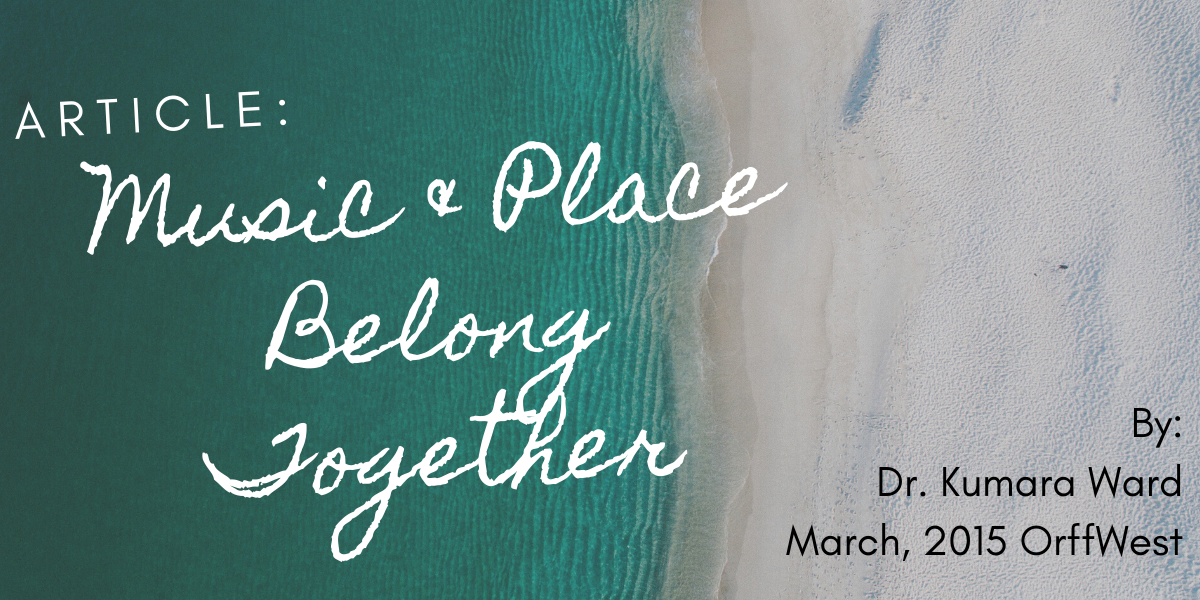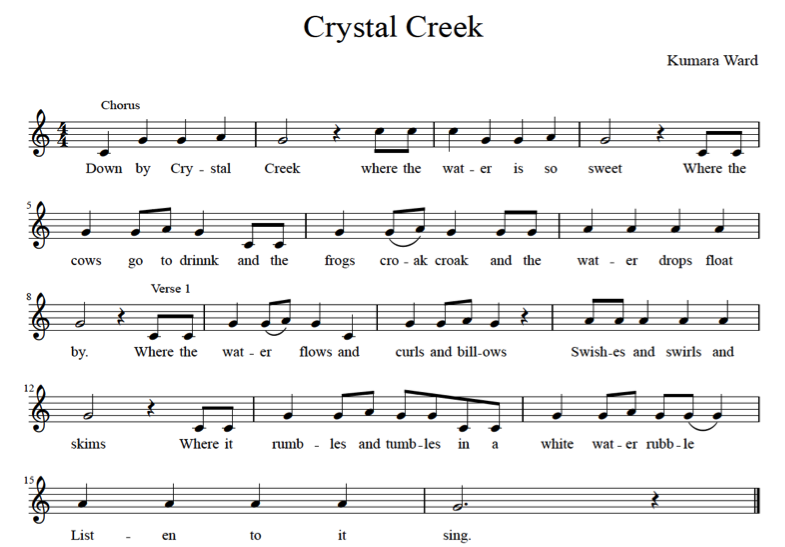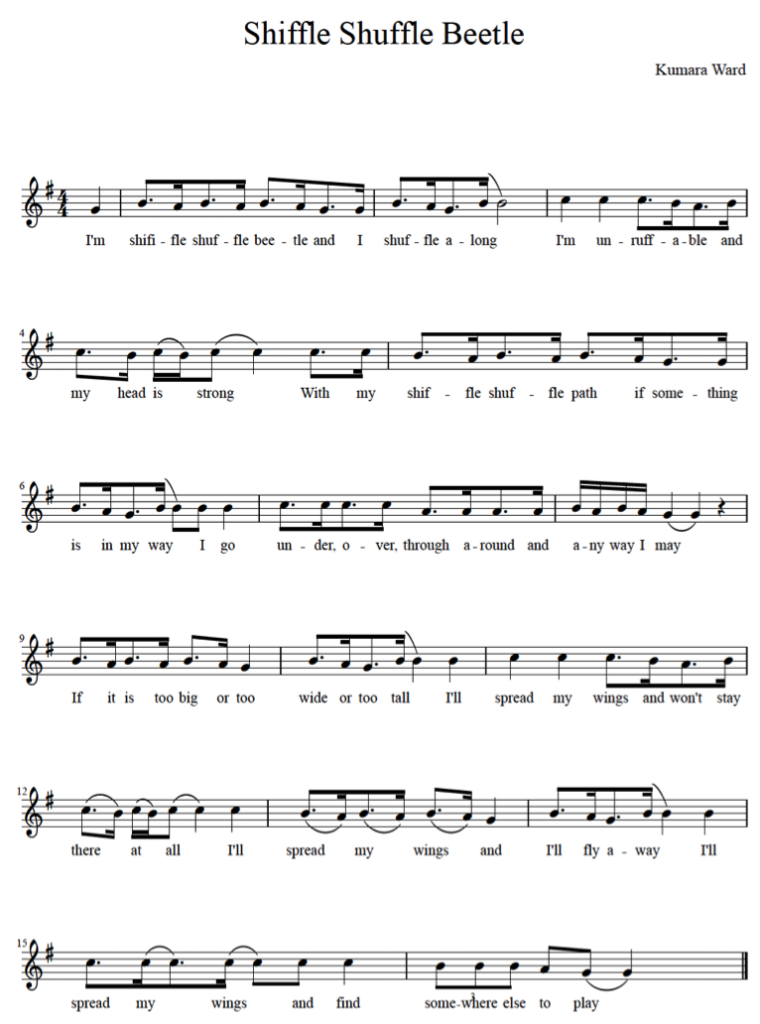Music and Place Belong Together
By: Dr. Kumara Ward
Lecturer in Curriculum and Pedagogy
University of Western Sydney
Music is part of every society. The seemingly infinite genres of music are testament to the societal, cultural and geographical influences on humans. My intention in this contribution is to highlight the way in which the local environment and the natural world become key elements for creating music and, in turn, teaching music to young children. In taking this approach we reflect the local environment back to the children, helping them to unpack and understand their environment and their place in it. This approach also helps to meet the requirements of the cross-curricula priority of sustainability. In addition, working with young children to express their environment through music helps them to develop a sense of place and belonging, which are precursors to developing stewardship toward the environment and the natural world.
I start with examining the local environment. Each local or regional area has a unique configuration of flora, fauna and insect life. It is easy to imagine the beat established by the gait of a wombat or wallaby and how different this might be from the rhythmic motif of a water dragon suddenly rushing off into the creek. The soaring of an eagle is distinctly different from the fluttering of a butterfly. The local geographical features such as creeks, beaches, forests or mountains are also specific to those areas. The sound of water rushing in the local creek, waves crashing on the shore or bird song are inherently musical. The sound of the wind rustling the grass is fundamentally different to the sound of the wind in a thunderstorm. Sounds of traffic, people rushing along the street and the hustle and bustle of city life are full of rhythmic patterns, which can also be used to create music, mood, drama and movement – all of which are fundamental to Orff principles of creative music teaching.
Below are two songs that I wrote for two different groups of children. The following paragraphs briefly describe the process I use to develop musical experiences for children and then consider ways in which the songs could be used. My practice for the regular music session with Kindergarten or infants and primary school children was to create music and songs based on characters from stories that were being featured in other parts of the program – from English to Mathematics to Humanities. These stories were self-generated and contained all the elements of good storytelling such as a setting, plot, characters, action, challenges, intercessions and resolution. The settings were natural world habitats of various kinds and the characters their inhabitants. As the schools I worked in were in semi-rural areas and there are few topics in the curriculum that can not be modelled, described or demonstrated through features of the animal, insect and plant worlds, this approach assisted the children in getting to know the local flora and fauna and their characteristics. However, the principles applied here are relevant to any environment that has sounds, movement and life.
Verse 2
With a splash and a dash
And a crash and foam
You’ll hear the water fall
Then a sprinkle and tinkle of airborne drops
Makes hardly a sound at all.
Crystal Creek was a local creek near the school. The children and I walked its banks often and knew the areas where the water rushed, where it bubbled and where it flowed. This song began to form as the children and I were walking along the path beside the creek and I completed it that night for the lesson the following day. As the children knew the place, the animals and the water features described in the song, it became one of ‘their songs’ and quickly hit the Kindy Top 10! The variety of water movement described in the song provided opportunities for children to use a range of percussion instruments and encouraged listening so they knew when their part appeared. There was also considerable scope in this song, even for the kindergarten children, for small groups to take singing parts.
When a musical experience is so relevant to the children, they often take it, and the story that preceded it, into their play, providing further opportunity to explore the rhythms, melodies, and the characters. The symbiotic relationship between the musical elements and the ‘grounded story’ approach meant that the children remembered these songs for a long time and the inherent musical features of them became key elements of their understanding of, and appreciation for music. Indeed, I now regularly see on Facebook, my Kindy students from many years ago sharing which of their old kindergarten songs they sing to their own children!
The second song shown came about a little differently. I was preparing lessons one evening and was at a loss for inspiration for a music lesson for the next day. My pencil lay idle my notepad. However, it was summer and the Christmas Beetles were out. One landed on my notepad and began to walk around. It encountered the pencil and turned to walk along it as if it were looking for another way around it. This path seemed to take too long so it turned back and began to push the pencil along the notepad. It persisted until it had pushed the pencil to the edge of the notepad and then turned around. I picked up the pencil and put in in front of it again and it continued to push it for a while and then got tired and flew off. This persistence seemed to be a useful analogy and this episode became my story for the next day – with a new song about Shiffle Shuffle Beetle. This song also proved to be popular with the children and saw them finding many Christmas Beetles and trying processes similar to the one I had experienced the night before. The persistence of this beetle became a metaphor for the children who were amazed at how strong the beetle was, how determined and how decisive. The song lent itself to singing in turns, movement, percussion and drama.
Crystal Creek and Shiffle Shuffle Beetle are just a two examples of the hundreds of songs I created with and for children that were based on what was happening in their worlds, in their environments. They became their songs that reflected their places, and their opportunities for understanding and expressing their places became infinitely richer through music.
Dr Kumara Ward is a member of the Centre for Educational Research at University of Western Sydney in the sustainability research group. She was a kindergarten and primary school teacher in Steiner Education for 15 years, a children’s book publisher and a Vocational Education Teacher in Early Childhood studies. She now lectures in curriculum and pedagogy with an emphasis on encouraging educators to develop their own creative teaching resources that reflect the children’s lives and environments. Her research includes working with young children, early childhood educators and teachers to develop awareness of and connection with their local natural environment through music, drama and visual arts. Her work emphasises investigation of the local natural world and creative interpretation of it through music.
Dr Kumara Ward
Centre for Educational Research: Sustainability, Lecturer: Early Childhood, Curriculum and Pedagogy
School of Education, University Of Western Sydney
Email: k.ward@uws.edu.au
This article has been taken from the March, 2015 OrffWest Newsletter





